This is a Canon P 35mm rangefinder which was sold between 1959 and 1961. The P stands for “Populaire”, meaning it was marketed as a budget (or popular) choice compared to higher spec Canon cameras. The P was very similar to the Canon VI-L, but lacking some of it’s features like adjustable viewfinder. Still, the Canon P is a very well built camera that remains one of the most popular rangefinders of all time. It uses the same M39 lens mount made popular by Leica and all of it’s clones, meaning that a huge variety of lenses can be used on this camera. It used a very unique metal foil focal plane shutter that was both more reliable and quieter than the cloth curtains common in rangefinders at the time. The viewfinder is very bright and easy to use and has projected brightlines for 35, 50, and 100 mm lenses. Although it lacked an exposure meter, there was an accessory meter that clipped onto the cameras shoe which was sold around the same time.
Film Type: 135 (35mm)
Lens: multiple
Mount: M39 Screw Mount
Focus: 3 feet to Infinity
Type: Coupled Rangefinder
Shutter: Metal Steel Foil Focal Plane
Speeds: B, 1 – 1/1000 seconds
Exposure Meter: None
Battery: None
Flash Mount: Coldshoe and M and X Flash Sync
Manual: http://www.cameramanuals.org/canon_pdf/canon_p-3.pdf
History
After World War II, the Japanese camera market completely exploded. There were no less than a dozen companies all developing models based off German rangefinders. The most often copied was the Leica II and III. Wikipedia has a short page dedicated to companies who made Leica copies. That page lists the 11 most common models, 6 of which were Japanese, by manufacturers all over the world who all released models with the same basic design. Although the Wikipedia article only lists 11, there were countless other examples that either never made it past the prototype stage, or sold in very small quantities. Further complicating a complete list of all copies, many of these models were made by one company, but sold under different names.
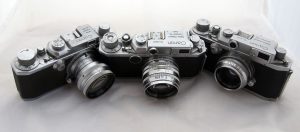
All of these cameras had the following characteristics:
- Coupled Rangefinder
- 39mm diameter screw lens mount with 1mm pitch
- 28.8mm film plane distance
- Uses 135 format 35mm film
- Cloth focal plane shutter
In the years that followed, some of these early Leica copies would continue to evolve and incorporate new features not included in the original Leica. As the Japanese camera industry grew, many of these companies got really good at creating their own unique models that could compete with, and in some ways, were superior to the models Leitz continued to make after the war.
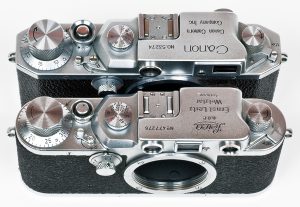
While several Japanese camera makers had some success with Leica based rangefinders, perhaps the most successful was Canon. Canon had actually been making Leica clones since before the war, but after the patents and designs became freely available, the design and quality of Canon’s cameras increased dramatically.
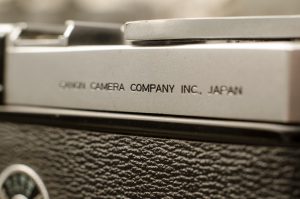
Canon would continue to evolve the original Leica design with many of it’s own design elements, and as the 1950s progressed, the Canon rangefinder started to look less and less like that original camera. When the Canon VT was released in 1956, the top and bottom plates of the camera had a completely unique design and the viewfinder windows were much larger and contained a rotating prism to change between 3 different lens focal lengths. It had a bottom “trigger style” film advance which is said to be faster than a top mount, a revised tripod socket, and an all new integrated self timer. Canon had already begun to develop a strong reputation as a quality maker of precision instruments that rivaled that of the German companies that Canon’s design was originally based off, but the VT was the first model to prove that Canon could bring something new to the market.
By the mid 1950s, the Single Lens Reflex (SLR) style of camera was growing in popularity very quickly. While other Japanese companies rushed to the market with their own SLR designs, Canon took their time, not releasing their first SLR until 1959, making them one of the last Japanese companies to do so.
One of Canon’s biggest competitors at the time, Nippon Kogaku (later known as Nikon) would abandon the rangefinder design almost overnight in favor of their own line of F-series SLRs, but not Canon. While Canon did have their own successful line of SLR cameras, they stayed in the rangefinder market much longer than other Japanese companies due to their great success at it.
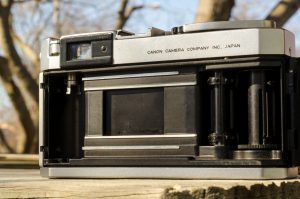
In the years to come, Canon would continue to innovate, replacing the cloth curtain which was common among almost all focal plane cameras, with a thin stainless steel curtain that was said to be quieter and immune to burn holes caused by leaving the camera exposed to direct sunlight. The Canon VI L released in 1958 was considered to be one of the best looking and best designed cameras in the world. Even today, in the collectors market, the VI L is one of Canon’s most sought after models because of it’s extremely high build quality, long list of features, and excellent design.
In March 1959, Canon would release the Canon P which stood for “Populaire”. It was a lower spec version of the VI L that omitted the adjustable viewfinder but was otherwise the same. The Canon P could be purchased for as little as 37,700 yen (with Canon 50/2.8 lens), compared to the VI L which sold for 79,800 yen (with Canon 50/1.8 lens). Despite the loss of these two features and the cheaper price, the Canon P had the same build quality and shutter as it’s more expensive counterparts, plus it accepted all of the same lenses and accessories. It would seem that Canon chose wisely calling this the “Populaire” as it’s combination of extremely high build quality and affordable price meant that it sold pretty well. I’ve seen two estimates of how many were made, one estimating “around 90,000” and the other being more specific at 87,875 which I think is probably more accurate.
As the 1960s started, it was clear to Canon that the market for a high-spec 35mm rangefinder wasn’t what it once was, so in 1961, they introduced a smaller and less expensive line of fixed lens rangefinders known as the Canonet series. The Canonets would remain popular throughout the 1960s and well into the 70s before being replaced by point and shoot models.
Canon would revise their full size Leica-inspired rangefinders one last time and release the Canon 7 in September, 1961. The new Canon 7 included an uncoupled selenium light meter (later models had a CdS meter) prominently displayed on the front plate of the camera. Although the Canon 7 was a very well built camera, it exhibited the first signs of cost cutting and had top and bottom plates made of thinner metal and more die cast parts than the earlier models. If you hold a Canon 7 and any earlier model at the same time, the Canon 7 will feel lighter and ever so slightly cheaper.
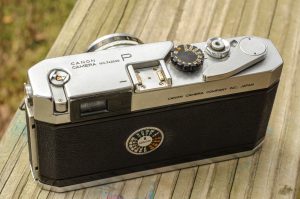
Today, all Canon rangefinders are still very desirable. This could be perhaps the most in demand camera in my entire collection. It’s strong reputation for great build quality, smooth operation, and compatibility with Leica Thread Mount lenses means that it has cross appeal to a variety of collectors. People wanting a Leica, but unable to afford one will often settle for Canon rangefinders. Some would even argue that “settle” isn’t a fair word, because in many ways these Canon rangefinders are superior to their German counterparts.
Whichever side of the fence you are on, there isn’t a single collector out there who would say these aren’t excellent cameras, both for display and use. The reputation of these Canon rangefinders comes with a price, however. Finding one in good working condition cheaply is very hard. People know these cameras sell for quite a lot, so you will be hard pressed to get one without a lens for under $100. If it has a lens attached, the price can double or even triple depending on which lens it is. If you’re on a budget the Canon P is a great choice and it works well with the Soviet M39 lenses like the Jupiter 8.
Repairs
None. Seriously. This camera came to me in perfect working order. OK, I had to wipe some dust off the body and it was ready to go. I don’t think this camera has been serviced any time recently. I just think that the Canon P was such a well built camera that it still works good today as it did 55 years ago.
It is worth mentioning that all Canon rangefinders from the VI L through the 7 had a thin stainless steel metal curtain that is prone to wrinkles over time. The wrinkles rarely cause an issue and are extremely common. It is nearly impossible to find one of these cameras with a wrinkle-free curtain and mine is no exception. If you do encounter one with wrinkles, as long as it is not torn or shows any other signs of physical damage, it will work fine.
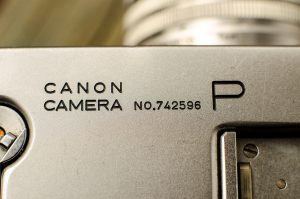
My Thoughts
It’s highly unlikely I will ever have a Leica. I honestly don’t even know if I want one. They’re very expensive and I simply do not want to spend the money to acquire a nice one. From what I’ve read, owning a Leica isn’t a magical experience that offers a shooting experience that transcends other cameras. Leicas are a luxury item, a status symbol in the film world. Maybe I have this attitude because I don’t have one. Maybe I’m a little bit jealous of those who do. Maybe if I owned a Leica, I would feel differently about it. Regardless, this Canon P is probably the closest I’ll ever come to owning one, and that’s OK with me.
By the time the Canon P came out, quite a bit had already changed since Canon’s original Leica inspired designs, yet some things remained. Both cameras still use the same lens mount, they still have excellent focal plane shutters, they each have large and bright rangefinder windows, and they’re each both well built. Upon receiving this Canon P, I was torn about how I should feel. On paper, this is the best and most sought after film camera in my collection, yet it shoots the same film and operates in the same manner as many other cameras that I already owned. This camera wasn’t going to suddenly make my photographs better, it doesn’t have any features that other cameras didn’t already have, and being an all manual camera, I’d still have to do as much thinking while shooting with this thing as other manual cameras.

Yet, there’s something satisfying about holding this camera and shooting it. The shutter is quiet and the shutter makes a “shick” sound each time it’s fired. The slow speeds have a unique sound unlike any other camera I’ve heard. The shutter curtain itself is made of metal foil. This camera uses the M39 lens mount which means I could use my Jupiter 8 and Industar lenses from my Soviet rangefinders. The Canon came, oddly enough, with a Nippon Kogaku (Nikon) Nikkor 50/2 lens. In those early days before the SLR wars, Nikon made glass for other companies, and their M39 lenses were quite good.
Something interesting about using this particular Nikkor lens on the Canon P is that the Canon’s minimum focus distance is 3 feet, but the Nikkor goes down to 2. This means that there is a point where the rangefinder will stop moving, but the lens will continue to focus on closer objects. Between 2 and 3 feet, the camera becomes a sort of scale focus camera. I doubt it’s something I’ll try often, but it is interesting to think of the closeup possibilities with an excellent lens like this.
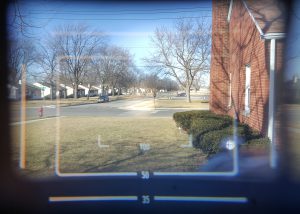
Another feature of the Canon P that was a cost cutting method compared to Canon’s more expensive models, is that the viewfinder has frame lines for 35, 50, and 100mm in the viewfinder window all at the same time. This actually can get a little distracting, especially if you only have 50mm lenses like I do. The image to the left shows what the framelines look, although that image was captured with my cell phone and is a little off center, but it still gives you an idea of what you see.
Other Canon models have a viewfinder that slides back and forth depending on the position of a switch which gives the correct coverage of a 35 and 100mm lens. The static frame lines were one way Canon was able to sell the Canon P for so much less than the VI that came before it.

Loading film into the camera is a pretty uneventful process as it works like any other camera you’ve ever used with the exception of the door lock. Apparently someone at Canon was very serious about not letting that door open accidentally as the Canon P has both a rotating lock on the bottom of the camera, and the usual lift up latch on the side of the camera. When the rotating lock on the bottom of the camera is in the “locked” position, a little metal pin sticks out blocking the latch on the side of the camera from moving.
Once film is in the camera, there’s not much else to do. You can use the film reminder dial on the rear of the camera if you wish, but it doesn’t actually do anything. It truly is just a reminder, and since this camera was made in 1959, it does not show all modern film speeds, so there’s really no need to use it anyway.
This is a meterless mechanical camera, so there is no power switch, or anything to turn on. You just wind the lever to cock the shutter and fire away. The shutter release itself is threaded for a cable release, and has a locking collar around it to lock the shutter release if you wish to prevent accidental shots.
My Results
I actually shot two rolls of film in this Canon P before getting anything developed which isn’t normal for me, but I felt pretty good about the camera, so I took a risk on a roll of Kodak Max 400, and a roll of expired Kodak Ektar 100. Most of the shots were done outdoors on a nice weekend in Chicago, but a few of the other shots were done elsewhere.
The results were a mixture of awesome and very good, with just a little bit of bad. The only bad news is that I have some sort of light leak that shows up on the extreme edge of some shots. It is consistently in the same place, which leads me to believe its the door hinge, but upon inspection of the camera after getting the film back, I can’t see where a light seal would even go. There isn’t anything there on mine. Perhaps there was once a strip of felt there that has been removed by a previous owner or maybe just over time, the camera’s bits and pieces are less light tight than they used to be. Before I shoot another roll of film I will cut a piece of adhesive black felt and line it up with the door hinge to prevent this in the future.
For everything else, I was extremely pleased at the results. Considering the Ektar was expired by about 20 years, it still rendered outdoor shots really well. I took the camera into the Red Line subway and even the poorly lit shots came out nicely exposed, although a bit grainy. I shot everything using Sunny 16 without any type of light meter. I guess it’s testament to how capable of a camera this is that one can reasonably shoot two entire rolls of film in challenging lighting conditions all by guessing exposure.
The Nikkor lens was as described, sharp and sharper. There was no chromatic abberation or any type of softness of the edges. Frankly, this is an amazing lens, and although its widest aperture is only f/2, I cannot really imagine that an f/1.8 or even faster lens could look any sharper, at least not on 35mm. When I first started shooting with this camera, at first I was sorry that I didn’t have an actual Canon lens to go on the P, but now that I see the incredible results of the Nikkor, I am fine with it. If anything, I think it makes the camera that more interesting. Maybe I’ll find a Minolta neck strap and put it in a Pentax bag to really throw people off!
Enough of the talk, lets see some samples!
On some of these photos, I was able to crop out the light leak, but it’s still visible on the others. The subway shots are really impressive to me because I was shooting them as slow as 1/15 hand held. In every case, I would lean up against a post or a wall to stabilize myself. I mentioned earlier that the Nikkor lens can focus as close as 2 feet, which I attempted once, but of course I didn’t get the focus right, so I am not sharing it here. Nevertheless, the Nikkor is an amazing lens, which really shouldn’t surprise me considering their reputation as a premiere optics company up to this very day. It’s just really cool to know that I have a lens from the 1950s that is every bit as good as the lenses they make now.
Edit 7/14/2016: After seeing the light leaks on this camera, I decided to replace the door seals on the camera with some adhesive backed black felt that I regularly use when restoring cameras. When I received this camera, I did not think the light seals needed any attention but after seeing the results from that first roll, it became evident light was getting in. So with some new felt around the door, I shot another roll this past spring. It took me awhile to get that film developed, but after I did, I was pleased to see that the light leaks were gone.
My Final Word in the next section nicely sums it up but I’ll say it again, the Canon P is an awesome camera. It is a precision instrument that looks good, is built extremely well and is capable of amazing shots. I might be a Yashica Electro fan boy, but I honestly think that in terms of quality, this is the best rangefinder in my collection.
My Final WordHow these ratings work |
The Canon P is a very good, no, EXCELLENT camera that looks good, is easy to use, is extremely well built, and rarely, if ever fails. It uses the 39mm Leica Thread Mount meaning there are hundreds of lenses to choose from, it has a very reliable and accurate metal foil shutter, and one of the largest and brightest viewfinders of any camera in my collection. Frankly, there isn’t much that you could do to make this camera better, but it’s worth noting that this camera is almost too good. If you enjoy vintage film cameras for their quirks and uniqueness, the Canon P might not be for you. This camera does everything so well, it’s almost boring to use. But if you need a camera that you can trust will never fail you, and delivers shot after shot of excellent photographs, this is an excellent choice. | ||||||
| Images | Handling | Features | Viewfinder | Feel & Beauty | History | Age | |
| 2 | 2 | 1 | 2 | 2 | 0 | 20% | |
| Bonus | None | ||||||
| Final Score | 10.8 | ||||||
Additional Resources
https://www.cameraquest.com/canonp.htm
http://www.photoethnography.com/ClassicCameras/CanonP.html
http://www.dantestella.com/technical/canonp.html
http://pixelogist.me/2012/04/14/the-canon-p-rangefinder-a-review-of-sorts/
http://camera-wiki.org/wiki/Canon_P
http://camarasclassicas.blogspot.com/2010/08/canon-p-populaire.html
http://web.archive.org/web/20150118051854/http://www.kuroneko-camera.com/cameras/canon_p.html

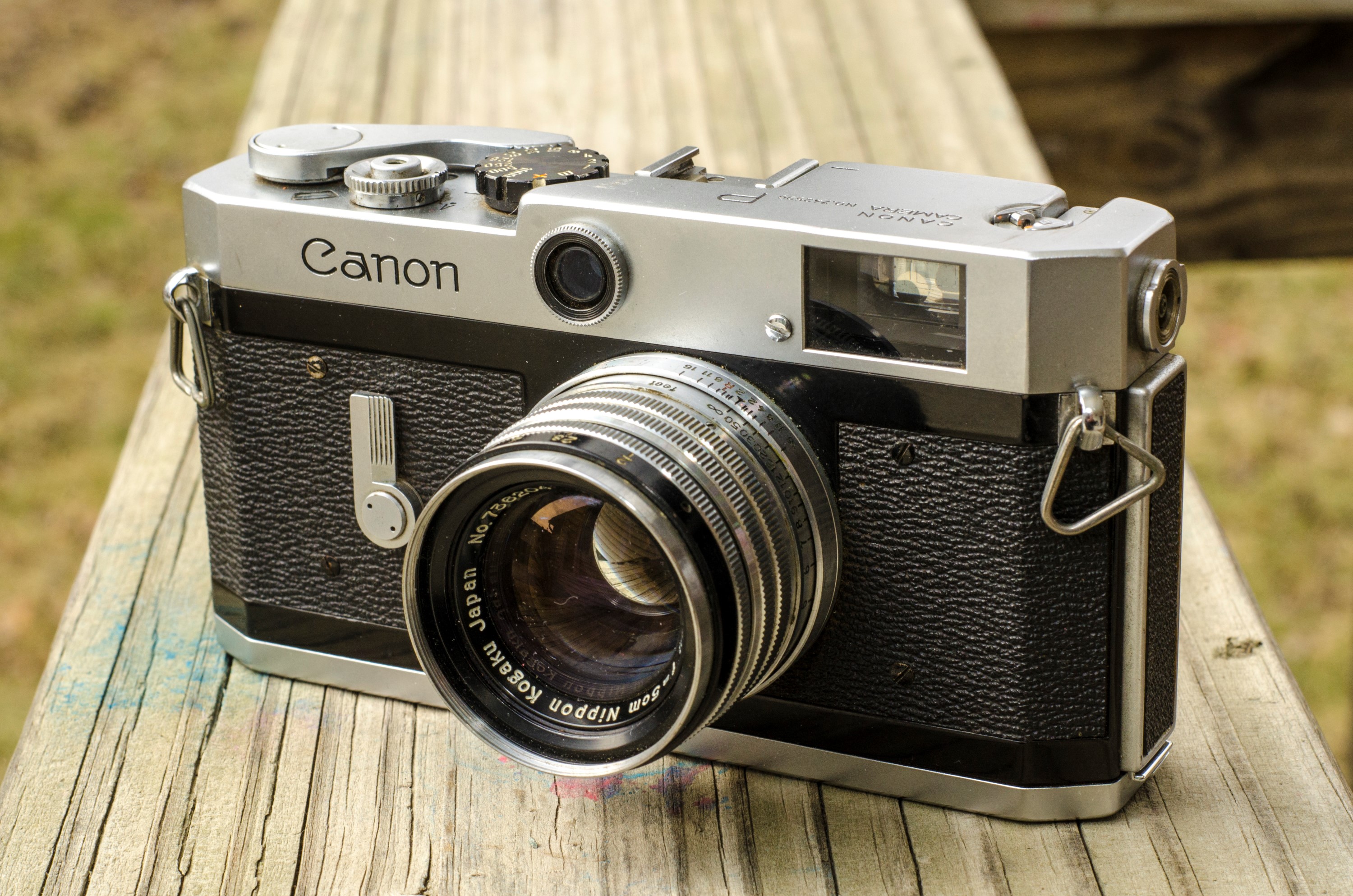

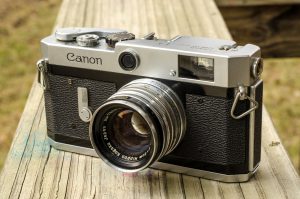



























You can shine a flash light from the front of the camera(without lens) in a darkroom and check if one of the curtain is torn at the place where it is clipped into the metal clip. My Canon-7 had similar light leak, and the curtain was torn away from the clip by a tiny bit, hence the light leak on extreme edge.
Great review. My thoughts on the P mirror yours. I have had mine for a couple years now and love it. I mostly shoot mine with a 35mm f/2.5 Voigtlander Color-Skopar. I am in love with that focal length. Another good design of the P is the ease of adjusting the rangefinder – you don’t have to be a technician to safely accomplish the task.
Great write up as usual Mike.
One note though – you seem to think that the back latch setup is overly concerned with accidental release as it appears to have two locks. This is not the reason for the bottom twist lock.
Early Canons (and Leicas, Contaxes, Kievs, and Nikons) had special cassettes for bulk 35mm film. These cassettes needed to be opened and closed through a twisting action prior to unloading film. THAT is what the twist lock does, it is there to open and close the custom film cassette (look inside as you turn it). The twist lock blocks the back latch since you want to make sure the cassette is in the “closed” state prior to opening the back.
Keep up the nice articles Mike!
Steve, thank you for the compliment, but also a big THANK YOU for the clarifying information! I had never heard this explanation before, and find it interesting that Ive seen these rotating locks on many other cameras and never understood what their original purpose was!
I will modify the review to include your insights! 🙂
Great review. I thoroughly enjoyed It since I have my own Canon P since one year back.
Great review very informative and your pictures look great, just ordered a P myself this past week. I also live in Chicago, was wondering where do you get your film developed? If its local or you mail it out.
Thank you for the feedback, Kim. I generally send my film to Dwayne’s Photo in Parsons, KS. I have also used Willow Photo Lab, in Willow Springs, MO as they have the least expensive developing and scanning prices of anywhere I’ve found.
Hi Mike, i just got a “P” ( in the Netherlands) and have just read your review. Great review to read and my compliments for it. Somewhere you say : “There is also no parallax correction on this model”.
IMO the viewfinder on the P is parallax corrected. I can clearly see it when i focus from far away to about 1 meter on my “P”.
Edwin, thanks for the correction. You are absolutely right, the Canon P’s viewfinder is parallax corrected. I do not know how I missed that. I will update the review! 🙂
Great writeup! I found one for only $4.99 at a local thrift shop — and it came with all 3 Canon lenses 😮 The 35 and 100 are mint, but the 50mm has some fungus starting and a dented filter rim. Photos: https://www.instagram.com/p/BpN5xrkh701/?taken-by=brianpowell
Love it and will test some film soon,
Holy cow Brian, what a find. My body came from Japan without a lens and I paired it with the Nikkor M39 lens that I already had. I couldn’t imagine finding a set like that altogether even for $100, let alone what you paid!
Hey Mike, great article! I am wondering about the light leak problem you were having, I am looking at buying a canon P and the seller mentions with sample photos the identical type of issue and has not diagnosed the cause. It’s been a few years since you wrote this, but how does your Canon P fare after all this time? Are you confident the issue was with the light seals? I was seeing on some posts online that issue might be cause by the shutter. Thanks!
Hi Kien, yes, I definitely feel confident that adding in a piece of light seal along the door hinge eliminated the light leaks. I have heard of others reporting the same problem that for some reason, a lack of a seal near the hinge causes a light leak. I find it strange as by then, most companies were including some type of felt or foam light seal material, whereas most Canon P’s are found without that. So either they always fall off, leaving no trace of their existence, or somehow Canon thought it wasn’t necessary. You can use any number of precut light seal kits found online, or just go to an arts and crafts store, and look for a sheet of adhesive backed black felt and cut it to size, which is what I do. I’ve been using the same sheet for over 6 years now and have used it to make light seals on probably 30-40 cameras.